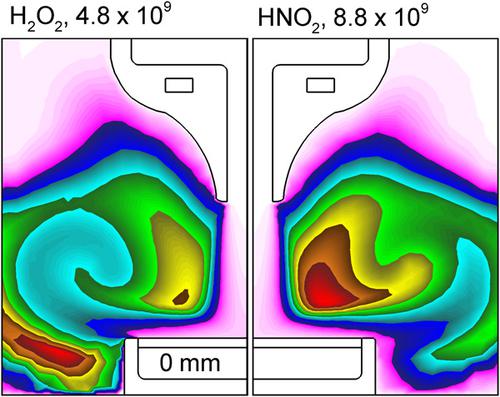当前位置:
X-MOL 学术
›
Plasma Processes Polym.
›
论文详情
Our official English website, www.x-mol.net, welcomes your
feedback! (Note: you will need to create a separate account there.)
Helium plasma jet interactions with water in well plates
Plasma Processes and Polymers ( IF 2.9 ) Pub Date : 2019-12-17 , DOI: 10.1002/ppap.201900179 Soheila Mohades 1 , Amanda M. Lietz 2 , Juliusz Kruszelnicki 2 , Mark J. Kushner 1
Plasma Processes and Polymers ( IF 2.9 ) Pub Date : 2019-12-17 , DOI: 10.1002/ppap.201900179 Soheila Mohades 1 , Amanda M. Lietz 2 , Juliusz Kruszelnicki 2 , Mark J. Kushner 1
Affiliation

|
Funding information US National Science Foundation, Grant/Award Number: PHY‐1519117; NSF Graduate Research Fellowship Program; US Department of Energy Office of Fusion Energy Science, Grant/Award Numbers: DE‐SC000319, DE‐SC0014132 Abstract Plasma activation of liquids or cell cultures is a method for investigating the consequences of plasma produced reactive oxygen and nitrogen species (RONS) on living systems. The reproducible transfer of RONS, ions, electrons, and photons to the liquid is critical for determining reaction mechanisms and biological outcomes, and depends strongly on system parameters. A common in vitro method of plasma treatment of cells is a plasma jet directed into a well plate filled (or partially filled) with a liquid cell growth media. This method of treatment intrinsically has several environmental and geometrical factors that could lead to variability in the activation of the media. Uncontrolled or unreported geometrical and environmental factors that affect this transfer can, therefore, influence the reproducibility of measurements. In this paper, results from a numerical modeling investigation of a pulsed helium plasma jet interacting with water in a well plate are discussed while varying the height of the well‐plate rim. The height of the rim changes gas flow patterns, the ratio of He‐to‐air, and the water vapor content in the gas layer above the liquid. With a low rim, gas flowing from the jet stagnates on‐axis and flows radially outward with few vortices that recirculate reactants. With high rims, the gas flow is dominated by vortices and recirculation. With a low rim, the ionization wave (IW) from the jet strikes the liquid and proceeds as a surface IW across the water. With higher rims, the densities of helium and water vapor are higher above the liquid, which results in a volumetric propagation of the IW, initially producing higher densities of H2, HO2, OH, and H2O2. The end result is that for otherwise identical conditions, the densities of solvated H2O2aq and select reactive nitrogen species increase with rim height due to the vortices that recirculate reactants.
中文翻译:

氦等离子体射流与孔板中的水相互作用
资助信息 美国国家科学基金会,资助/奖励编号:PHY-1519117;NSF 研究生研究奖学金计划;美国能源部聚变能源科学办公室,资助/奖项编号:DE-SC000319、DE-SC0014132 摘要 液体或细胞培养物的等离子体活化是一种研究等离子体产生的活性氧和氮物质 (RONS) 对生命的影响的方法系统。RONS、离子、电子和光子向液体的可重复转移对于确定反应机制和生物学结果至关重要,并且在很大程度上取决于系统参数。细胞等离子体处理的常见体外方法是将等离子体射流引导到填充(或部分填充)有液体细胞生长培养基的孔板中。这种处理方法本质上有几个环境和几何因素,可能导致介质激活的可变性。因此,影响这种转移的不受控制或未报告的几何和环境因素会影响测量的再现性。在本文中,讨论了在改变井板边缘高度时脉冲氦等离子体射流与井板中水相互作用的数值模拟研究结果。边缘的高度会改变气体流动模式、氦气与空气的比例以及液体上方气层中的水蒸气含量。由于边缘较低,从射流流出的气体在轴上停滞并径向向外流动,几乎没有使反应物再循环的涡流。对于高边缘,气流以涡流和再循环为主。低边,来自射流的电离波 (IW) 撞击液体并以表面 IW 的形式穿过水面。对于较高的边缘,氦气和水蒸气的密度高于液体,这导致 IW 的体积传播,最初产生更高密度的 H2、HO2、OH 和 H2O2。最终结果是,在其他条件相同的情况下,由于再循环反应物的涡流,溶剂化 H2O2aq 和选择的活性氮物质的密度随着边缘高度而增加。
更新日期:2019-12-17
中文翻译:

氦等离子体射流与孔板中的水相互作用
资助信息 美国国家科学基金会,资助/奖励编号:PHY-1519117;NSF 研究生研究奖学金计划;美国能源部聚变能源科学办公室,资助/奖项编号:DE-SC000319、DE-SC0014132 摘要 液体或细胞培养物的等离子体活化是一种研究等离子体产生的活性氧和氮物质 (RONS) 对生命的影响的方法系统。RONS、离子、电子和光子向液体的可重复转移对于确定反应机制和生物学结果至关重要,并且在很大程度上取决于系统参数。细胞等离子体处理的常见体外方法是将等离子体射流引导到填充(或部分填充)有液体细胞生长培养基的孔板中。这种处理方法本质上有几个环境和几何因素,可能导致介质激活的可变性。因此,影响这种转移的不受控制或未报告的几何和环境因素会影响测量的再现性。在本文中,讨论了在改变井板边缘高度时脉冲氦等离子体射流与井板中水相互作用的数值模拟研究结果。边缘的高度会改变气体流动模式、氦气与空气的比例以及液体上方气层中的水蒸气含量。由于边缘较低,从射流流出的气体在轴上停滞并径向向外流动,几乎没有使反应物再循环的涡流。对于高边缘,气流以涡流和再循环为主。低边,来自射流的电离波 (IW) 撞击液体并以表面 IW 的形式穿过水面。对于较高的边缘,氦气和水蒸气的密度高于液体,这导致 IW 的体积传播,最初产生更高密度的 H2、HO2、OH 和 H2O2。最终结果是,在其他条件相同的情况下,由于再循环反应物的涡流,溶剂化 H2O2aq 和选择的活性氮物质的密度随着边缘高度而增加。











































 京公网安备 11010802027423号
京公网安备 11010802027423号